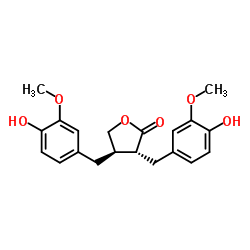Matairesinol

Matairesinol structure
|
Common Name | Matairesinol | ||
|---|---|---|---|---|
| CAS Number | 580-72-3 | Molecular Weight | 358.39 | |
| Density | 1.3±0.1 g/cm3 | Boiling Point | 593.0±45.0 °C at 760 mmHg | |
| Molecular Formula | C20H22O6 | Melting Point | N/A | |
| MSDS | Chinese USA | Flash Point | 212.3±22.2 °C | |
|
Optimum yields of dibenzylbutyrolactone-type lignans from Cynareae fruits, during their ripening, germination and enzymatic hydrolysis processes, determined by on-line chromatographic methods.
Phytochem. Anal. 23(6) , 598-603, (2012) Dibenzylbutyrolactone-type lignans are the physiologically active constituents of the achene fruits of Cynareae. These lignans occur in glycoside/aglycone forms: in the highest quantity of the arctiin/arctigenin, matairesinoside/matairesinol and tracheloside/... |
|
|
Lignans inhibit cell growth via regulation of Wnt/beta-catenin signaling.
Food Chem. Toxicol. 48(8-9) , 2247-52, (2010) As aberrant activation of Wnt/beta-catenin signaling is one of the major mechanisms of carcinogenesis in colon cancer, identification of inhibitors of this pathway may aid in colon cancer prevention. We investigated the ability of the lignans arctiin, mataire... |
|
|
Cytotoxic and HIF-1alpha inhibitory compounds from Crossosoma bigelovii.
J. Nat. Prod. 72(5) , 805-12, (2009) Cytotoxicity-guided fractionation of an organic solvent extract of the plant Crossosoma bigelovii led to the discovery of a new strophanthidin glycoside (1) and two new 2-methylchromone glycosides (2 and 3). Also isolated were the known chromones eugenin and ... |
|
|
Antiproliferative activity of lignans against the breast carcinoma cell lines MCF 7 and BT 20.
Arch. Gynecol. Obstet. 285(4) , 1145-51, (2012) Phytoestrogens are plant-derived, non-steroidal phytochemicals with anticarcinogenic potential. The major structural classes are the isoflavones and lignans. The aim of this study was to compare the effect of the plant-derived lignans secoisolariciresinol and... |
|
|
Inhibition of the discoloration of yellowtail dark muscle by lignan.
Biosci. Biotechnol. Biochem. 73(8) , 1718-21, (2009) The inhibitory effect of (-)-, (+)-matairesinol and (-)-, (+)-secoisolariciresinol on the discoloration of dark muscle (chiai in Japanese) of two-year-old yellowtail (hamachi in Japanese) was evaluated by measuring the X and a(*) values. (-)-Matairesinol was ... |
|
|
Among plant lignans, pinoresinol has the strongest antiinflammatory properties in human intestinal Caco-2 cells.
J. Nutr. 142 , 1798-1805, (2012) Dietary lignans show some promising health benefits, but little is known about their fate and activities in the small intestine. The purpose of this study was thus to investigate whether plant lignans are taken up by intestinal cells and modulate the intestin... |
|
|
Intake of the plant lignans matairesinol, secoisolariciresinol, pinoresinol, and lariciresinol in relation to vascular inflammation and endothelial dysfunction in middle age-elderly men and post-menopausal women living in Northern Italy.
Nutr. Metab. Cardiovasc. Dis. 20(1) , 64-71, (2010) It has been suggested that lignan intake may decrease the risk for cardiovascular disease (CVD) by modifying traditional risk factors as well as aortic stiffness. However, the role of dietary lignans on the vascular system is largely unknown. The objective wa... |
|
|
Metabolic engineering of lignan biosynthesis in Forsythia cell culture.
Plant Cell Physiol. 50(12) , 2200-9, (2009) Lignans are a large class of secondary metabolites in plants, with numerous biological effects in mammals, including antitumor and antioxidant activities. Sesamin, the most abundant furofuran-class lignan in sesame seeds (Sesamum plants), is produced by the c... |
|
|
A preparative isolation and purification of arctigenin and matairesinol from Forsythia koreana by centrifugal partition chromatography.
J. Sep. Sci. 29(5) , 656-9, (2006) Centrifugal partition chromatography was applied to separate arctigenin and matairesinol from Forsythia koreana extract with a two-phase solvent system composed of n-hexane-ethyl acetate-methanol-water (5:5:5:5 v/v). Using this method, arctigenin and mataires... |
|
|
Wounding response in xylem of Scots pine seedlings shows wide genetic variation and connection with the constitutive defence of heartwood.
Tree Physiol. 29(1) , 19-25, (2009) In this greenhouse experiment, 3-year-old Scots pine (Pinus sylvestris L.) seedlings were wounded by drilling holes through the stem. In the xylem next to the wound, the concentration of resin acids (RAC) increased, and the production of extractives typical f... |